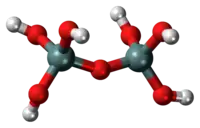Silicic acid
In chemistry, a silicic acid (/sɪˈlɪsɪk/) is any chemical compound containing the element silicon attached to oxide (=O) and hydroxyl (−OH) groups, with the general formula [H2xSiOx+2]n or, equivalently, [SiOx(OH)4−2x]n.[1][2] Orthosilicic acid is a representative example. Silicic acids are rarely observed in isolation, but are thought to exist in aqueous solutions, including seawater, and play a role in biomineralization.[3] They are typically colorless weak acids that are sparingly soluble in water. Like the silicate anions, which are their better known conjugate bases, silicic acids are proposed to be oligomeric or polymeric. No simple silicic acid has ever been identified, since these species are primarily of theoretical interest.
Depending on the number of silicon atoms present, there are mono- and polysilicic (di-, tri-, tetrasilicic, etc.) acids. Well defined silicic acids have not been obtained in a form that has been characterized by X-ray crystallography.
Examples
| Formula | Name | Computed Structure |
|---|---|---|
| H 4SiO 4 or Si(OH) 4 | orthosilicic acid |  |
| H 2SiO 3 or SiO(OH) 2 | metasilicic acid |  |
| H 6Si 2O 7 or O(Si(OH) 3) 2 | pyrosilicic acid |  |
| H 2Si 2O 5 or Si 2O 3(OH) 2 | disilicic acid |  |
Reactions
Silicic acids can be seen as hydrated forms of silica, namely 2 H2xSiOx+2 = SiO2·(H2O)x. Indeed, in concentrated solutions, silicic acids generally polymerize and condense, and ultimately degrade to silicon dioxide and water. The intermediate stages may be very thick liquids or gel-like solids.[4][5][6] Dehydrating the latter yields a hard translucent form of silica with atomic-scale pores, called silica gel, which is widely used as water absorbent and drying agent.
Silica dissolves very sparingly in water and is present in seawater at concentrations below 100 parts per million. In such dilute solutions, silica is assumed to exist as orthosilicic acid. Theoretical computations indicate that the dissolution of silica in water proceeds through the formation of a SiO2·2H2O complex and then orthosilicic acid.[7]
The silicon–oxygen double bond of metasilicic acid, implied by the formula H2SiO3, is hypothetical or highly unstable. Such double bonds can be hydrated to a pair of hydroxyl (−OH) groups:[4]
For example,
or
Alternatively, metasilicic acid is liable to form cyclic polymers [−SiO(OH)2−]n, which can be opened by hydration to chain polymers HO[−SiO(OH)2−]nH. Similarly, disilicic acid is liable to form complex polymers with a tetravalent unit, [=Si2O3(OH)2=]n. Conversely, oligomeric and polymeric acids may depolymerize by hydrolysis of the Si−O−Si bridges, or such bridges may be created by condensation:
Like organic silanols, silicic acids are weak acids. Orthosilicic acid has calculated dissociation potentials pKa1 = 9.84, pKa2 = 13.2 at 25 °C.
Silicic acids and silicates in solution react with molybdate anions, yielding yellow silicomolybdate complexes. This reaction has been used to titrate the content of silicon in water solutions and determine their nature. In a typical preparation, monomeric orthosilicic acid was found to react completely in 75 seconds, dimeric pyrosilicic acid in 10 minutes, and higher oligomers in considerably longer time. The reaction is not observed with colloidal silica.[8]
The degree of polymerization of silicic acids in water solution can be determined by its effect on the freezing point of the solution (cryoscopy).[8]
History
Silicic acid was invoked by Jöns Jacob Berzelius in the early 19th century to explain the dissolution of silicon dioxide (silica, quartz) in water, namely through the hydration reaction:
Based on the vapor pressure curves for silica gel, Reinout Willem Van Bemellen argued that no silica hydrates existed, only silica gel. On the other hand, Gustav Tschermak von Seysenegg believed that he had observed different silicic acids as decomposition products of natural silicate gels.[9]
The first crystalline silicic acid was prepared from the phyllosilicate natrosilite (Na2Si2O5) in 1924. More than 15 crystalline acids are known and comprise at least six modifications of H2Si2O5. Some acids can adsorb and intercalate organic molecules, and therefore are interesting alternatives to silica.[10]
Preparation
Crystalline silicic acids can be prepared by removing the sodium cations from solutions of sodium silicates with an ion-exchange resin, or by treating sodium silicates with concentrated sulfuric acid.[10]
See also
References
- Greenwood, N. N.; Earnshaw, A. (2012). Chemistry of the Elements. Elsevier Science. p. 346. ISBN 978-0-08-050109-3. Retrieved July 27, 2022.
- Iler, R. K. (1979). The Chemistry of Silica. New York: Wiley. ISBN 0-471-02404-X.
- Frank Wigglesworth Clarke (1914). "The Silicic Acids" (PDF). The Constitution of the Natural Silicates. pp. 10–19.
- W. E. Gye and W. J. Purdy (1922): "The Poisonous Properties of Colloidal Silica. I: The Effects of the Parenteral Administration of Large Doses". British Journal of Experimental Pathology, volume 3, issue 2, pages 75–85. PMC 2047780.
- Katsumi Goto (1956): "Effect of pH on Polymerization of Silicic Acid". Journal of Physical Chemistry, volume 60, issue 7, pages 1007–1008. doi:10.1021/j150541a046.
- Hans Ramberg (1952): "Chemical Bonds and Distribution of Cations in Silicates". The Journal of Geology, volume 60, issue 4, pages 331–355. doi:10.1086/625982.
- Bhaskar Mondal, Deepanwita Ghosh, and Abhijit K. Das (2009): "Thermochemistry for silicic acid formation reaction: Prediction of new reaction pathway". Chemical Physics Letters, volume 478, issues 4–6, pages 115–119. doi:10.1016/j.cplett.2009.07.063.
- G. B. Alexander (1953): "The Reaction of Low Molecular Weight Silicic Acids with Molybdic Acid". Journal of the American Chemical Society, volume 75, issue 22, pages 5655–5657. doi:10.1021/ja01118a054.
- Robert Schwarz; Ernst Menner (1924), "Zur Kenntnis der Kieselsäuren", Ber. Dtsch. Chem. Ges. (in German), 57 (8): 1477–1481, doi:10.1002/cber.19240570850.
- "Silicates", Ullmann's Encyclopedia of Industrial Chemistry (7th ed.), 2007, doi:10.1002/14356007.a23_661.